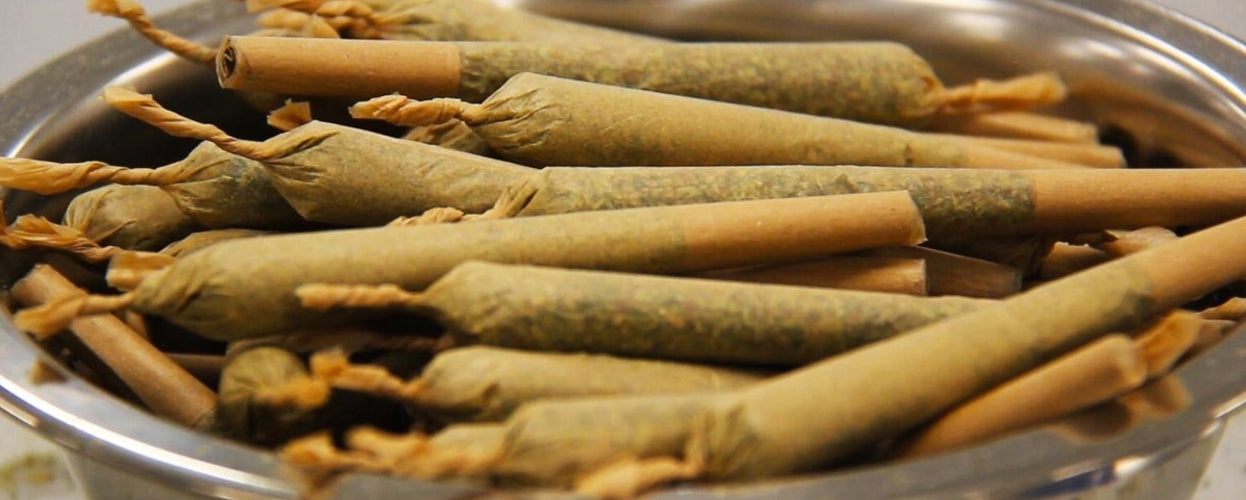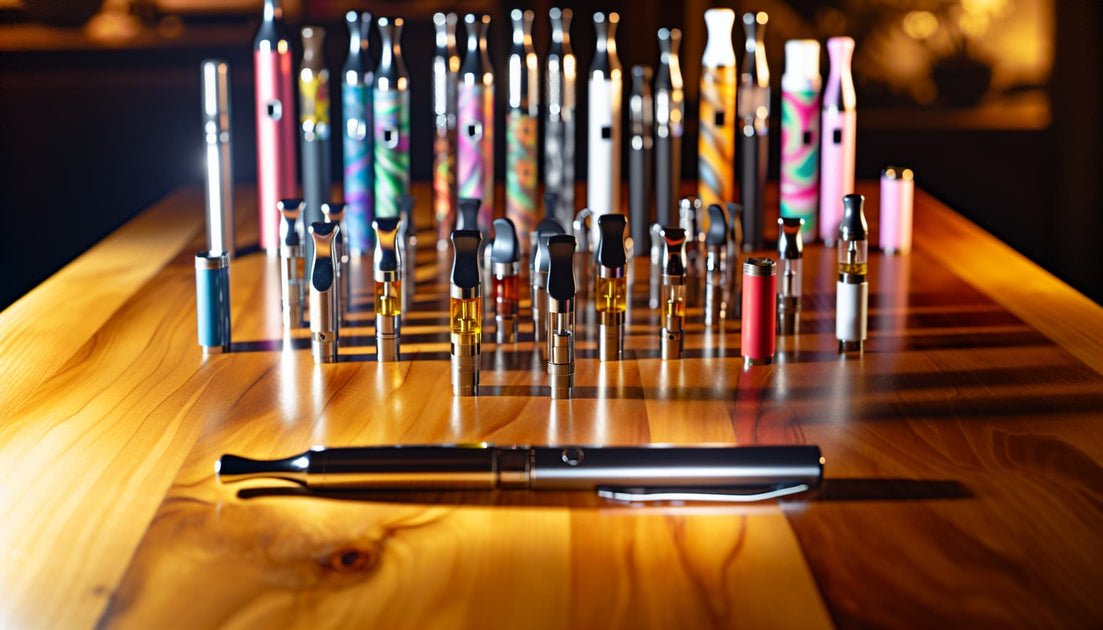Your cart is currently empty.

How to Roll cone Joints? If your rolling game is improving but you think your joints lack a certain “wow” factor, you’re in the right place. In this intermediate guide to rolling a joint, we’ll be looking at easily the most popular style of the joint around the world – the cone.
During the following How to Roll a Cone guide, we’ll be covering everything you need to know to elevate your skill set and start making joints to be proud of. By the end, you should know:
- The reasons why people love to roll a cone joint.
- How to prepare your ingredients for creating a cone.
- All about the different papers available on the market.
- How to make a roach that will support any sized cone joint.
- How to pack your papers and distribute the ingredients correctly.
- Finally, how to roll a cone!
With loads to cover in this guide about how to roll a cone, we’d better get started already!

Image credit: Key to Cannabis
Why Roll a Cone Joint
A cone is a name given to a joint that is conical in shape. Unlike a cigarette or a more basic joint, the tip of the cone will be thinner than the roach end. The chunkier end should always be the one that the smoker lights. This will taper down towards the roach end.
People like to smoke cones because they look cooler than a regular straight joint. If you picture the most famous stoners on the planet – the Snoop Doggs, Cypress Hills, and the Bob Marleys of the world – you’ll likely imagine them with a big old cone joint!
It’s not just style that has helped the cone joint win the hearts many fans around the world though. The cone is functional too. Being fatter at the tip, the roller can pack much more cannabis in without compromising the smoking experience.
Although a straight joint could technically hold more, many smokers don’t like to wrap their lips around a big cigar-like joint, and making a good roach for such builds is much trickier. The wider the diameter of the roach, the more likely it is to let ingredients from the joint pass through. Smokers don’t usually like getting a mouth full of weed from a toke of a joint.
Pick Your Papers
How to roll a cone out of paper? Now we know the why, so let’s not waste any more time in getting onto the how to roll cone joints . The first thing you’re going to absolutely need is smoking papers. Choosing your paper is going to be a lot down to personal preference as well as individual skill level at using them.
We’ll talk you through the key distinguishing features of different rolling papers below.
Size
Rolling papers come in all different sizes. Some are long and wide; some are shorter and narrower. Smokers tend to match their papers to the size of the joints they like to smoke. If you regularly smoke with friends, passing the joint around, bigger papers, such as Rowll's un-bleached king-sized papers will be preferable. However, if you’re happy just smoking solo cones alone, you might prefer smaller papers like the ones from Elements.
Another thing to be aware of when buying your first papers is that larger cones are more difficult to make than smaller ones. If you’re just starting out, we recommend perfecting a small cone before ramping up the girth and length to smoke out your mates!
Finally, papers also come in different widths. Wider papers, like those from Pure Hemp, allow rollers to create fatter cones. However, like with longer joints, this is a skill that needs practicing. That said, novice rollers will likely find it easier to make a regular-sized cone using very wide papers. There is a larger margin for error with wider papers and it’s less likely that they’ll spill the contents when crafting a cone.
Material
As well as different lengths and widths, papers come in a few different materials. The most common is, of course, the paper of some description. However, rolling “papers” made entirely of plant cellulose exist too. As cool as products like cellulose papers from Clear may look, WeedRepublic does not recommend them for novice rollers. Get used to rolling cones with paper first before you graduate!
Even within the world of paper rolling papers, there is quite a bit of diversity. Papers come in various thicknesses too. Experienced rollers will usually swear by a product like OCB's Slim Fit Papers. Made using incredibly thin paper, making a joint with them is trickier than if you were to use a thicker grade of paper. The advantage of such papers is that the smoker tastes more of their cannabis and less of the paper itself!
There are also rolling papers that are aimed at the more ethically conscious smoker. Products like those from RAW are all-natural and have not been bleached as pure white rolling papers commonly have. Some will be made out of pure hemp too, which is even kinder to the planet than traditional paper production is.
 |
For the expert rollers out there, these Slim Fit papers from OCB are a must have. Light up more plant material and less paper! |
 |
No article about rolling papers would be complete without mentioning RAW. Completely natural, these papers guarantee a smooth, even burn every time you light up. |
Which Papers Should a Novice Roller Buy?
If you’ve never rolled a cone, or even any kind of joint, before, it’s best to practice with something that will make the job as easy as possible. Below, WeedRepublic has given some pointers for those choosing their first pack of papers:
- Shorter papers are easier – Avoid long, thin rolling papers for your first few joints.
- Narrow papers are tricky – Novice rollers often find very narrow papers are a challenge to work with.
- Thin paper is more difficult to roll – Thin rolling papers tend to be less grippy and offer less support when actually rolling. This makes them more difficult to work with.
- Avoid weird papers! – At first, stick with papers that are made from paper. A great cone in the simple rolling paper is much cooler than a dreadful one made using fancy cellulose papers!
Sort Your Ingredients
Armed with some papers, you’re ready to start processing your product for use in a joint. The process here will depend on what it is that you’re actually smoking. For the sake of simplicity, we’re going to presume that you’re smoking a joint of pure bud. Rolling a hash joint or a spliff (with tobacco) is going to be a slightly different process.
To sort your cannabis buds out, follow the steps below:
- Ensure your cannabis is properly dried before use. Wet cannabis will not grind or smoke well in a joint. Choose some drier buds from your stash or consider quick-drying your cannabis if it’s all you have.
- If you have scales, you can weigh out about 0.5g of dry bud to process. Otherwise, you’ll have to guess the amount. You can always grind up a bit more or save any excess if over or undershoot at first.
- Tear apart, cut up, or grind your cannabis buds. There are loads of different grinders on the market these days, such as DankGeek's Lightning Grinder for budget smokers or the Death Star grinder for the stoner who has everything. Purpose-built grinders are by far the best method for processing buds. However, ripping them apart with fingers, grating them on a cheese grater, or finely chopping with a pair of scissors will also work.
- You want to grind, cut, or rip your buds until they are broken down into considerably smaller pieces (< 2mm x < 2mm). The idea is that when you roll the contents of your joint, you will be able to shape it without sharp twigs piercing the paper or big lumps causing blockages.
- Set your ground cannabis to one side ready to load into the rolling paper.
 |
You're going to want a quality grinder to bring out all of the THC content from your favorite cannabis strain. Try DankGeek's 4 Piece Lightning Grinder, the perfect grinder for anyone on a budget. |
 |
For the friend who has everything already, get them a themed grinder like this super effective Death Star Grinder. Wondering why it's so awesome? We write in detail about it in our 11 Best Weed Grinders article! |
All About Roaches
A roach is to a joint what a filter is to a cigarette. It gives the smoker something to hold onto and provides some filtration for a smoother toke. Whereas a cigarette filter is typically made from foam, a roach is almost always thin cardboard.
A good roach is more important when making a cone than it is for a regular straight joint. The tip of the joint opposite the roach will be heavier on a cone. Therefore, the roach end needs to be able to support more weight. This will demand a slightly sturdier and maybe longer roach than you’d find on a straight joint.
To make a roach, you want to take a piece of thin card (the kind of cardboard rolling papers are packaged in is ideal). Cut or tear the card into a long thin piece about 5cm x 1.5cm. Roll the cardboard into a cylindrical shape. Remember, the mouth end of your cone needs to be thinner than the tip. If your roach looks a little fat, you can always unroll it, trim a little from the end, and roll it up again.
When rolling up a roach, make it as tight as you can. The roach provides a level of filtration and also stops any loose bits from the joint itself from ending up in your mouth. The rolled paper will expand slightly as you roll the cone joint itself. Make it very tight to begin with so when it relaxes it doesn’t end up too wide.
Pack Your Papers
With a roach made, it’s time to load your rolling papers. To do that, follow the steps below:
- Place a single rolling paper in front of you. You want the gum side (a shiny strip along the top of the paper) to be away from you and pointing towards the ceiling.
- Put your roach into the joint on the side of the hand that you write with. You want it to sit flush with the edge of the paper, not overlapping or having excess paper overlap it.
- Now add your cannabis to cover the rest of the paper.
Distribution
A crucial, yet often-overlooked, aspect of making a great cone joint is distributing your ingredients correctly. When you roll the joint, it will take the shape of the ingredients to a large degree. You, therefore, want more cannabis towards the tip of the joint than near the roach.
Ideally, you want your roach to sit snugly into the cannabis around it. When the ingredients are slightly compacted, there should be a perfectly straight line from the narrow roach to the tip of the joint. The tip will be quite a bit fatter, of course.
You can pick the joint up at this point and roll the contents back and forth between your fingers and thumbs. Feel for bits that have too much weed in, not enough, lumpy bits, or perhaps even twigs that could pierce the rolling paper. Add cannabis, take it away, or redistribute it until you can shape the contents into what feels like a cone before you’ve even started to roll it properly.

Image Credit: Key to Cannabis
The Important Bit!
Finally, it’s time to actually roll a cone joint. This is the part that takes a lot of practice so don’t worry if you mess it up the first time around. In fact, if you do, just rip your joint apart and try to roll a cone again! Practice makes perfect and perfect joints are always popular.
Talking a novice through exactly how to roll a cone joint isn’t easy but here goes!
- Carefully pick up the rolling paper, complete with contents.
- Hold the loaded paper in front of you between your thumb and fingers. Your thumbs should be towards you and fingers supporting the back of what will be your cone joint.
- Roll your thumbs gently forwards and backward to start shaping the joint. If you distributed the contents correctly, it should quickly start looking like a cone.
- When you’re happy with the shape, concentrate on rolling the joint around the roach itself. If you manage to roll it successfully at the mouth end, the rest will usually follow.
- With the hand you write with on the roach end, and other hand supporting the joint, roll your thumbs down further than when you were shaping the cone joint. Keep going until it becomes possible to slip the edge of the paper behind the roach and the rest of the joint.
- Tuck the paper in as mentioned in the previous step and roll the opposite way.
- Continue to roll upwards until only the gum sticks out. Lick the gum and stick it down to complete the cone joint.
- With a thinnish item (pen, cigarette, pencil, etc.) poke down the end opposite the roach. This will neaten the job up, take out any slack from the cone joint, and allow the smoker to twist the paper at the end so weed doesn’t fall out in transport.
- Voila! Your very first cone (hopefully!)

Image Credit: Key to Cannabis
Roll a Cone Joint: Practice, Practice, Practice!
Armed with the above knowledge, you should now feel more confident in your ability to take your rolling up to the next level. Truth be told, once you have a solid straight joint in your arsenal, transferring the skills shouldn’t be that tricky.
Like with most things in life practice will make perfect. Even if it seems impossible, just keep those rolly fingers going and soon enough your friends will be looking to you to do the honors!

. Written by Megan Medeiros (BA)
Written by Megan Medeiros (BA)
Megan Medeiros has a bachelor’s degree in English and is currently working on a master’s in English at James Madison University. She's the owner and operator of Medeiros Writing, and has been working as a cannabis writer for the past three years, mostly following the legal climate of marijuana, especially in areas like California, Colorado, Oregon, Canada, and other legal areas.
This post contains references to products from one or more of our advertisers. We may receive compensation when you click on links to those products. For an explanation of our Advertising Policy, visit this page. All photos were sourced from Pinterest.com | updated 2021









